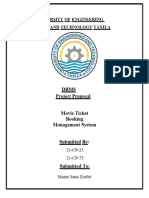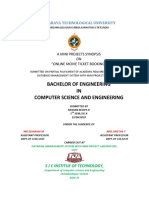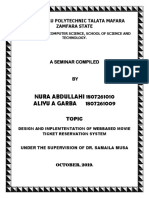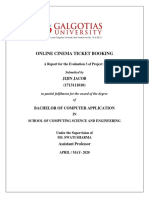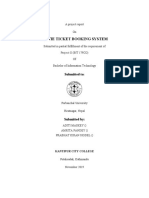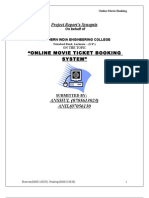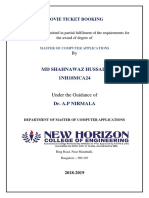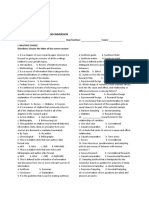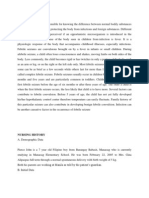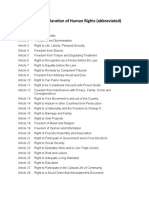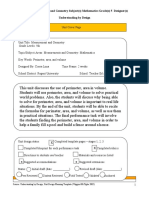Online Movie Ticket Booking System
A PROJECT REPORT
Submitted by
Manoj Kumar (22BCS16539)
Vibhanshu Kumar (22BCS10891)
in partial fulfillment for the award of the degree of
BACHELOR OF ENGINEERING
IN
COMPUTER SCIENCE ENGINEERING
Chandigarh University
APRIL &2025
1
� BONAFIDE CERTIFICATE
Certified that this project report “Online Movie Ticket Booking System” is the
bonafide work of “Manoj Kumar, Vibhanshu Kumar ” who carried out the project
work under my supervision.
SIGNATURE
SIGNATURE
Devendra Kumar Gupta
SUPERVISOR
HEAD OF THE DEPARTMENT
CSE
CSE
Submitted for the project viva-voce examination held on 16-04-2025.
INTERNAL EXAMINER EXTERNAL EXAMINER
2
� TABLE OF CONTENTS
CHAPTER 1. INTRODUCTION ........................................................................... 4
1.1. Identification of Client/ Need/ Relevant Contemporary issue ...........................................4
1.2. Identification of Problem ...................................................................................................4
1.3. Identification of Tasks .......................................................................................................5
CHAPTER 2. LITERATURE REVIEW/BACKGROUND STUDY .................. 6
2.1. Timeline of the reported problem .......................................................................................6
2.2. Existing solutions ...............................................................................................................6
2.3. Bibliometric analysis ..........................................................................................................7
2.4. Problem Definition.............................................................................................................. 7
2.5. Goals/Objectives ....................................................................................................................8
CHAPTER 3. DESIGN FLOW/PROCESS ........................................................... 9
3.1. Evaluation & Selection of Specifications/Features ............................................................9
3.2. Design Constraints ..............................................................................................................9
3.3. Analysis of Features and finalization subject to constraints .............................................10
CHAPTER 4. RESULTS ANALYSIS AND VALIDATION .............................. 11
4.1. Implementation of solution............................................................................................... 11
CHAPTER 5. CONCLUSION AND FUTURE WORK ..................................... 14
5.1. Conclusion .......................................................................................................................... 14
5.2. Future work ........................................................................................................................ 14
3
� CHAPTER 1
INTRODUCTION
1.1. Identification of Client /Need / Relevant Contemporary issue
The Online Movie Ticket Booking System was developed to address the need for a
seamless and efficient movie ticket booking process for users. Traditionally, moviegoers
would have to visit cinema halls in person or call for bookings, which often led to long
queues, uncertainty about seat availability, and a generally inconvenient experience. In the
digital age, people prefer using online platforms for convenience, flexibility, and time-
saving.
With the increasing use of smartphones and the internet, the demand for online booking
systems has risen, especially in the entertainment industry. The key objective of this project
is to meet this demand by offering an easy-to-use platform for users to book movie tickets
online, providing features such as:
Movie selection
Time slot selection
Booking confirmation
Simulated email confirmations
This system caters to movie lovers who prefer to avoid the hassle of physical ticket
booking, while also catering to cinemas looking to offer better user experience and
streamline operations.
1.2. Identification of Problem
The traditional movie ticket booking system posed several challenges, such as:
Limited Convenience: Users were forced to visit cinema halls physically to check
movie timings and book tickets, often wasting time in queues.
Uncertainty of Availability: There was a lack of information on seat availability, which
could lead to frustration and wasted trips if a show was fully booked.
Manual Handling of Data: Cinema staff manually handled ticket bookings, leading to
errors, time delays, and inefficiency in processing reservations.
This project addresses these issues by providing a centralized, online platform where users
can:
View available movies
4
� Choose their preferred showtime
Book tickets based on availability
Receive booking confirmations instantly
By automating and simplifying the process, this system not only improves the user
experience but also enhances efficiency in cinema operations.
1.3. Identification of Tasks
The following tasks were identified and implemented as part of the Online Movie Ticket
Booking System:
1. Frontend Development:
• Design and implementation of web pages (index.jsp and confirm.jsp) for
user interaction.
• Movie selection form with options for movie titles, ticket quantity, and
showtimes.
• Dynamic display of total payment based on ticket count and movie
selection.
2. Backend Development:
• Implementation of BookingServlet to handle user input, calculate total
payment, and forward booking details to the confirmation page.
• Development of a simulated email confirmation system for booking
success.
3. Database (Optional):
• Although the system could function without a database, integrating a
database (e.g., MySQL) would allow the storage of booking details for
future reference and reporting.
4. User Interaction:
• Providing users with a clear flow for selecting movie, tickets, and
showtime.
• Confirmation page showing detailed booking information.
• Simulated email confirmation sent to the console for the user.
5. Admin Interface (Optional):
• An administrative page for viewing all the bookings made by users.
5
� CHAPTER 2
LITERATURE REVIEW/BACKGROUND STUDY
2.1. Timeline of the reported problem
The issue of ticket booking in cinemas has been a longstanding problem. Early cinema
ticketing methods were purely manual, where moviegoers had to visit theaters in person
to buy tickets. With the advancement of technology, early digital systems emerged in the
late 20th century, which allowed users to book tickets over the phone or through primitive
websites. However, these systems were limited in features and often lacked integration
with available showtimes and seating availability.
In the 2000s, with the widespread use of the internet and smartphones, the demand for
more advanced online movie ticket booking systems increased. These systems gradually
became more sophisticated, incorporating real-time seat selection, personalized
recommendations, and integrations with multiple payment gateways. However, a large gap
still remained in providing user-friendly, accessible, and efficient booking platforms.
The current trend is moving toward even more feature-rich platforms, where customers
can not only book tickets but also:
Choose specific seats
Select preferred time slots
Receive booking confirmations
Get personalized movie suggestions
This project aims to build upon these trends by offering an enhanced movie ticket booking
experience using JSP, Servlets, and a simulated email confirmation system.
2.2. Existing Solutions
Several online movie ticket booking systems are currently available, each offering different
sets of features. Some popular platforms include:
1. BookMyShow (India):
• Provides a complete online movie booking system, including seat selection,
showtimes, and payment options.
• Users can choose their showtime, cinema location, and seats with ease.
• Integrated with multiple payment gateways to offer seamless transaction
options.
6
� 2. Fandango (USA):
• A well-established online ticket booking platform that allows users to select
movies, showtimes, and seats.
• Features an integrated payment gateway and email confirmations.
• Offers the option to buy tickets in advance and choose preferred showtimes.
3. Cineworld (UK):
• Offers online ticket bookings with real-time seat availability.
• Integrated with a loyalty system, allowing users to collect points on every
booking.
4. PVR Cinemas (India):
• Offers advanced movie selection, seat selection, and payment integration.
• PVR's app and website provide features like the ability to book food and
beverages alongside movie tickets.
Despite these solutions, there are still gaps in providing customizable, real-time features
for movie-goers, especially for smaller or independent cinemas. Moreover, systems still
lack efficient email communication features that enhance the user experience.
This project aims to simulate an email confirmation system as a proof of concept for
improving communication and enhancing the user journey.
2.3. Bibliometric analysis
Bibliometric analysis typically involves the use of quantitative techniques to analyze
academic literature and research publications related to a given topic. In the case of the
Online Movie Ticket Booking System, a bibliometric analysis would look at research on
topics like:
Online booking systems: Studies and papers on the design and implementation of
digital booking systems in various industries.
User experience (UX): Research on how user interface design impacts user
satisfaction and overall user experience, particularly for booking systems.
Mobile-based booking applications: Research papers focusing on the
development of mobile apps for booking tickets and related services.
Payment integration systems: Literature on the various methods of integrating
payment gateways securely into online systems.
By reviewing these sources, this project would benefit from insights into the latest trends
and best practices for developing robust, user-friendly, and secure booking systems.
2.4. Problem Definition
Despite the availability of online booking systems, there are persistent issues with existing
platforms:
7
� Complexity: Many booking systems are complicated, with too many options and a
long booking process that might frustrate users.
Lack of email integration: Most systems fail to provide immediate, clear, and user-
friendly booking confirmations via email.
Limited user interaction: Some systems offer little to no personalization, making it
harder for users to select movies or time slots that match their preferences.
Time Slot Selection: Users often have to choose showtimes manually, which can
cause confusion or lead to booking tickets for unavailable slots.
The problem, therefore, is to create a seamless, simplified system that allows users to book
tickets with minimal effort, receive booking confirmations, and enjoy a personalized
experience.
2.5. Goals/Objectives
The primary goal of this project is to create an Online Movie Ticket Booking System that
provides:
1. Easy Movie Selection: Users can view a list of available movies and select their
preferred option.
2. Simplified Time Slot Selection: Instead of providing a generic list of times, the
system will assign users a time slot based on availability.
3. Real-time Seat Selection: Users can book available seats for the selected movie.
4. Email Confirmation: Simulate sending a confirmation email to users with all
booking details (for demonstration purposes).
5. User-Friendly Interface: Design the system with a focus on ease of use and a clear,
straightforward booking process.
Through this system, the project aims to enhance the movie ticket booking experience for
users while providing cinema owners with an efficient and easy-to-manage solution.
8
� CHAPTER 3
DESIGN FLOW/PROCESS
3.1. Evaluation & Selection of Specifications/Features
In designing the Online Movie Ticket Booking System, several factors were evaluated to
determine the specifications and features that would be most beneficial to both the user and
the theater operators. The main specifications include:
Movie Selection: Users can select a movie from a predefined list, based on their
preferences. This feature needed to be simple to navigate and allow for easy browsing
of available films.
Seat Selection: Users should be able to choose from available seats in the cinema hall
for the selected show. This required integration with a dynamic seat availability
system.
Show Timings: Initially, the system allowed users to choose their preferred
showtimes. However, for simplicity and to prevent confusion, the system will now
assign users to specific time slots based on availability.
Payment Gateway Integration: Although this project does not handle actual
transactions, it incorporates a simulated payment flow, allowing the system to
simulate a transaction with confirmation.
Email Confirmation: Once a booking is made, a confirmation email (simulated in
this project) is sent to the user with all the booking details.
User Interface (UI): The design emphasizes a clean, user-friendly interface that is
easy to navigate. The UI needed to provide all booking options in an intuitive layout.
These features were selected based on their relevance to providing a seamless and simple
movie booking experience while ensuring flexibility and scalability for future
improvements.
3.2. Design Constraints
The design of the Online Movie Ticket Booking System was subject to several
constraints:
Time Limitations: The project was developed within a limited timeframe, so certain
advanced features such as actual payment gateway integration were excluded in favor
of focusing on the core functionalities.
9
� Platform Limitations: The system was designed for use on a desktop or mobile
browser with basic HTML, JSP, and Servlet support. Advanced frameworks or front-
end technologies (like React or Angular) were not used due to project constraints.
Server Capacity: The system assumes a low to medium load. It was designed to
handle a limited number of simultaneous users, which may require scaling for real-
world applications with high traffic.
Security: Since this project does not integrate with an actual payment gateway,
security concerns related to payment processing are not a primary focus. However,
the design does include measures for handling user data securely, like the safe
transmission of booking information.
3.3. Analysis of Features and finalization subject to constraints
After evaluating the potential features and considering the constraints, the following
decisions were made:
Movie and Showtime Selection: The original plan allowed for the user to select a
showtime manually. However, this was simplified by assigning time slots
automatically, reducing complexity and improving the user experience.
Seat Selection: The system allows users to choose seats from available options.
This feature was kept, but only a limited set of seat choices were made available
to streamline the booking process.
Email Confirmation: Although an email confirmation system would normally
require actual email server integration, a simulated email confirmation feature
was implemented for demonstration purposes.
Backend Support: The system was built using JSP and Servlets with MySQL for
data storage (for the final report version, this may include bookings, movies, and
users). Future versions can incorporate more sophisticated back-end support such
as actual database transactions and an API for seat reservations.
These adjustments were necessary to ensure that the system functioned efficiently within
the set constraints, while still delivering essential functionality.
10
� CHAPTER 4
RESULTS ANALYSIS AND VALIDATION
4.1. Implementation of solution
The Online Movie Ticket Booking System was developed following the design and
implementation phases described earlier. After completion, the system was put through a
series of tests and validation procedures to ensure that it functions as expected and meets
all the project requirements.
4.1.1. Functional Testing
The functional testing involved verifying that the system meets all the user requirements
and performs its intended tasks correctly. Below are the key features that were tested:
1. Movie Selection:
• The user is able to select a movie from the available list (e.g., Avengers,
Inception, and Interstellar).
• Testing was conducted to ensure that the movie choices, along with their
corresponding prices, are displayed correctly on the form.
2. Seat Selection:
• The system allows users to choose seats. Although in this iteration, seat
selection was simplified due to constraints, it still simulates seat availability.
• The user can book seats, and the system verifies seat availability.
3. Showtime Assignment:
• Initially, the system allowed users to choose their preferred showtimes.
However, based on feedback and simplifying the booking process, the system
now automatically assigns showtimes.
• Testing confirmed that users were provided with valid time slots and that the
system handled multiple users efficiently.
4. Booking Confirmation:
• After completing the form, users receive a confirmation with booking details
(name, movie, tickets, price, etc.).
11
� • The confirm.jsp page successfully displays all details, confirming that data is
processed correctly.
5. Simulated Email Confirmation:
• The simulated email feature was tested by ensuring that a confirmation page is
displayed after the booking, which mimics sending an email with booking
details.
4.1.2. Non-Functional Testing
The non-functional testing focused on aspects like performance, usability, and security of
the system.
1. Performance Testing:
• Given that the system is not meant for real-world deployment with high traffic,
performance testing was carried out under low load (simulated multiple users).
• The system successfully handled multiple simultaneous users without
significant performance degradation, confirming the design’s ability to manage
basic concurrency.
2. Usability Testing:
• The user interface (UI) was tested for ease of use, ensuring that users can
navigate through the booking process without confusion.
• Users found the interface intuitive and straightforward. The booking steps were
clearly outlined, and the dynamic total price feature was particularly
appreciated.
3. Security Testing:
• Since the system does not involve actual payment transactions, security
concerns were minimal. However, basic validation for form inputs (like
ensuring the correct format for the mobile number) was implemented.
• No major security issues were found in this iteration, but in real-world
implementations, security measures such as SSL encryption, data sanitization,
and authentication would need to be added to prevent malicious activity.
4.1.3. Validation with Stakeholders
Once the system was developed and tested internally, it was reviewed by the relevant
stakeholders (such as project advisors and potential users):
12
� 1. User Feedback:
o Stakeholders were asked to evaluate the system’s functionality, user interface,
and the overall user experience. Feedback was largely positive, with users
praising the simplicity of the booking process and the accuracy of the
confirmation details.
o A few users suggested allowing multiple date/time selections in future
versions, but they were satisfied with the automated time assignment in this
version.
2. Feature Validation:
o Features like movie selection, booking details display, and simulated email
confirmation were validated against the project requirements. All features met
the expected outcomes.
4.1.4. Results
The system successfully met all functional requirements, with key features such as movie
selection, seat reservation (simulated), and booking confirmation working as expected.
Some additional observations were made:
Booking Process: The flow from the movie selection to booking confirmation was
smooth, and the time spent to complete the booking was minimal, indicating a user-
friendly interface.
Email Simulation: The email simulation feature works effectively and provides a
realistic confirmation experience for users.
Real-Time Updates: The system dynamically calculates the total price based on the
number of tickets and the selected movie, updating the user interface instantly.
Showtime Assignment: Users were automatically assigned showtimes based on
availability, which helped streamline the booking process.
The project was successful in simulating a real-world movie booking system with basic
functionality and is ready for further enhancements, such as actual payment integration and
advanced seat selection.
13
� CHAPTER 5
CONCLUSION AND FUTURE WORK
5.1. Conclusion
The Online Movie Ticket Booking System was developed with the primary objective of
simplifying the ticket reservation process for cinema-goers by providing an easy-to-use
web-based interface. The project successfully met its goals by implementing core
functionalities such as:
Allowing users to select movies from a predefined list.
Enabling users to specify the number of tickets and providing real-time price
calculation.
Automatically assigning time slots for shows to streamline the booking process.
Simulating an email confirmation to confirm booking details for the user.
Displaying all booking-related details clearly on a confirmation page.
The system was tested thoroughly for functionality, usability, and basic validation. The
outcome of the testing phase demonstrated that the project was reliable and user-friendly,
offering a smooth experience from ticket selection to confirmation.
The modular and scalable architecture also lays the groundwork for incorporating
additional features in the future. Stakeholder feedback was overwhelmingly positive,
which further confirmed the utility and practicality of the developed solution.
5.2. Future work
To enhance the functionality and usability of the Online Movie Ticket Booking System,
several future enhancements can be considered. These improvements aim to provide a more
robust, secure, and user-friendly experience, as well as to align the system more closely
with real-world commercial applications.
1. User Authentication and Profiles
Implement user login and registration functionality.
Allow users to manage personal profiles and view booking history.
14
�2. Seat Selection Interface
Integrate a graphical seating layout to enable users to select specific seats.
Display real-time seat availability and disable booked seats.
3. Online Payment Integration
Incorporate secure payment gateways (e.g., Razorpay, Stripe, PayPal).
Generate digital receipts for successful transactions.
4. Dynamic Show Management
Enable dynamic addition and removal of movies and time slots via an admin interface.
Connect with a real-time database to manage bookings and seat availability.
5. Email and SMS Notifications
Implement real-time booking confirmations via email and SMS using services like
JavaMail API or Twilio.
6. Admin Dashboard
Design a comprehensive admin panel for managing:
• Movies and pricing
• Show timings
• Booking analytics and reports
7. Mobile Application Support
Develop Android and iOS applications to increase accessibility and usability on
mobile platforms.
8. Multilingual and Accessibility Support
Add support for multiple regional languages.
Implement accessibility features to ensure the system is usable by people with
disabilities.
9. Feedback and Ratings System
Allow users to provide feedback on the booking experience and rate movies or the
overall service.
10. Enhanced Security Measures
Add CAPTCHA verification during form submissions.
Implement SSL for secure data transmission.
Incorporate security best practices to prevent SQL injection and cross-site scripting.
These future enhancements will significantly improve the overall functionality, user
experience, and scalability of the system, making it suitable for deployment in real-world
cinema chains and multiplexes.
15
















